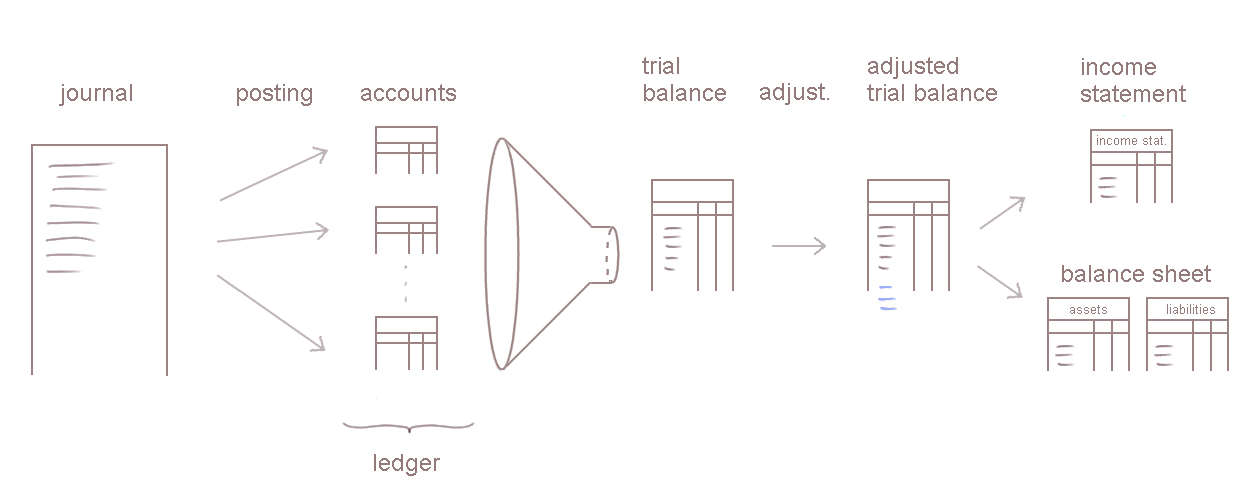General accounting
IV. 17. The balance of each account and the Trial balance
Video
We posted all the transactions of a complete accounting cycle into accounts. In our example we had 19 transactions in the Journal of the whole accounting cycle. They were posted (with double-entries) into 15 accounts.
Here are the 19 transactions:

and the 15 accounts into which they were posted:

These 15 accounts form the Ledger of the accounting system of the firm.
Let's look at the accounts one by one, in alphabetical order.
Bank account.

The bank account "received" 17000€ (recorded in the debit column), and "gave" 14500€ (recorded in the credit column).
So we say that it has a balance, in debit, of 2500€. And we write it like this (below):

Balance carried down and balance brought down.
Actually accountants have a way to compute the balance:
- they compute the total of each column, debit and credit
- they enter in the smaller column the difference with the bigger one, and call it the balance carried down
- then, they enter the same figure at the bottom of the other column (like I did above), and call it the balance brought down
Balance carried down:

And, then, balance brought down:

In this way, the two balances correspond to a double-entry which does not alter the accounting system.
Remember that accounting was invented at a time, the XIIIth and XIVth centuries in Western Europe, when calculations with arabic numbers were quite new and abstract, and the signs + and - had not been invented yet. They were invented around 1500.
This today-fancy-looking procedure was the way, in the Middle Ages, to "close" an account (i.e. "complete it" with the balance carried down entered in the smaller column), and write again the same figure (now the balance brought down) in the other column of whichever account we wanted (including the same) to make balanced entries in the accounting books.
When we speak with no further precision of "the balance" of an account, we mean the balance brought down.
Capital account.

The capital account records the shares given to the owner(s) in exchange for the initial money put into the firm (called the "initial capital").
Usually the capital account has few entries. In this example, it has only one. Therefore its balance is simply 10000€ in credit.
Cash account.

The cash account is, with the bank account, one of the two accounts which have a lot of entries.
Here the cash account "received" 16000€ (the total of the debit column), and "gave" 15000€ (the total of the credit column).
So its balance is 1000€ in debit.
Remember: a cash account cannot have a balance in credit, since it cannot have less than 0€ in banknotes and coins.
Deirdre account.
Deirdre is our supplier of goods.

We could have put these entries into a general "suppliers account", which would also have got entries for our purchase of a van and of machinery on credit. But we decided to split our suppliers from whom we get credit into separate accounts: Deirdre's, James's, and Jules's.
We purchased for 7000€ worth of goods from Deirdre (175 items at 40€ apiece), and we paid her only 1500€. So the account has a balance in credit of 5500€. This means that we still owe Deirdre 5500€.
Until we pay her, this remains a liability of the firm.
James account.
James is the firm from which we bought machinery. We bought it on credit, therefore an account had to be opened to record the IOU we sent James.

We obtained a credit of 5000€.
And we settled it the next day. So the account has a balance of zero.
Let's not list all the accounts, but go directly to the loan account.
Long term loan account.

We contracted a loan for 2000€ from a lender, our bank, another bank, or a lender of one sort or another. Later on we shall see how we can even get money directly from the bond markets.
And we haven't begun to pay it back. So the long term loan account has a balance in credit of 2000€.
It is a liability of the firm. And this kind of liability has a yearly cost, called the "financial charges", or "interest charges". But in this accounting cycle we supposed that there were no charges for the loan yet. (These charges would not appear in the long term loan acc. but in a "financial charges acc." and "cash" or "bank".)
Machinery account.

This account records an asset which arrived in our firm.
Be sure to understand that it is not here that we record the money owed to James and the payment we actually made to him.
Mini accounting software.
We shall not look at all the accounts one by one, but you are strongly encouraged to do so with the help of the mini accounting software which accompanies this lesson
https://www.lapasserelle.com/online_courses/accounting/trial_balance/mini_accounting.xls
The Trial balance.
Finally we prepare the list all the accounts and their balances.
This document is called "the Trial balance" of the end of the accounting period.

The two columns, debit and credit, must add up to the same figure, because all the postings into accounts had one entry in debit and one entry in credit with the same numbers.
If the two columns do not have the same total, something is wrong in the accounting.
But if the two columns are equal, it is not a proof that the accounting is right. (We could have made two mistakes which compensate each other.)
Progression in the accounting process over a complete accounting cycle.
We reached the Trial balance in the figure below:

In subsequent lessons, we shall study the adjustments which we will make to this Trial balance (to take into account special consumptions which do not appear naturally in the Journal of transactions). And we shall see how from the "adjusted Trial balance" we go to the Income statement and the Balance sheet.



